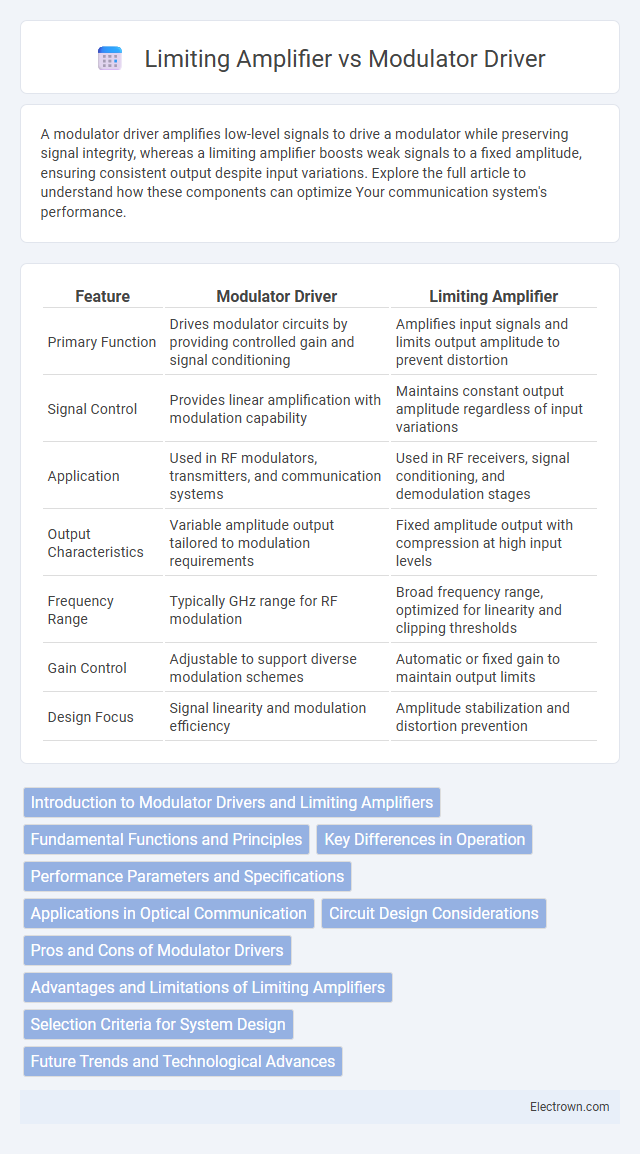A modulator driver amplifies low-level signals to drive a modulator while preserving signal integrity, whereas a limiting amplifier boosts weak signals to a fixed amplitude, ensuring consistent output despite input variations. Explore the full article to understand how these components can optimize Your communication system's performance.
Table of Comparison
| Feature | Modulator Driver | Limiting Amplifier |
|---|---|---|
| Primary Function | Drives modulator circuits by providing controlled gain and signal conditioning | Amplifies input signals and limits output amplitude to prevent distortion |
| Signal Control | Provides linear amplification with modulation capability | Maintains constant output amplitude regardless of input variations |
| Application | Used in RF modulators, transmitters, and communication systems | Used in RF receivers, signal conditioning, and demodulation stages |
| Output Characteristics | Variable amplitude output tailored to modulation requirements | Fixed amplitude output with compression at high input levels |
| Frequency Range | Typically GHz range for RF modulation | Broad frequency range, optimized for linearity and clipping thresholds |
| Gain Control | Adjustable to support diverse modulation schemes | Automatic or fixed gain to maintain output limits |
| Design Focus | Signal linearity and modulation efficiency | Amplitude stabilization and distortion prevention |
Introduction to Modulator Drivers and Limiting Amplifiers
Modulator drivers and limiting amplifiers are essential components in RF and communication systems, each serving distinct roles in signal processing. Modulator drivers amplify baseband or intermediate-frequency signals to drive modulators with precise gain and linearity, ensuring accurate signal modulation. Limiting amplifiers, on the other hand, provide fixed-gain amplification with amplitude limiting to maintain consistent output levels, preventing signal distortion and preserving signal integrity in variable input conditions.
Fundamental Functions and Principles
A modulator driver amplifies input signals to a suitable level for driving modulators in communication systems, ensuring precise control over signal modulation depth and linearity. Limiting amplifiers stabilize signal amplitude by clipping peaks to maintain consistent output levels, crucial for reducing distortion in digital transmission. Both components are integral in signal processing, but modulator drivers focus on controlled amplification, while limiting amplifiers emphasize amplitude stabilization.
Key Differences in Operation
A modulator driver primarily controls the amplitude and phase of a signal to prepare it for modulation, ensuring accurate signal shaping and timing. In contrast, a limiting amplifier amplifies input signals while clipping voltage to maintain consistent output amplitude, preventing signal distortion in communication systems. The modulator driver focuses on signal conditioning for modulation, whereas the limiting amplifier emphasizes stabilizing signal amplitude for reliable transmission.
Performance Parameters and Specifications
Modulator drivers typically emphasize linearity, gain flatness, and bandwidth to ensure precise modulation of RF signals, with noise figure and output power being critical specifications for optimal transmitter performance. Limiting amplifiers prioritize gain saturation point, dynamic range, and low distortion to maintain signal integrity under varying input levels, often featuring high compression points and fast transient response times. Both components require careful consideration of gain, noise figure, and linearity to optimize overall signal processing in communication systems.
Applications in Optical Communication
Modulator drivers play a crucial role in optical communication by amplifying and shaping electrical signals to precisely drive electro-optic modulators, ensuring high-speed data transmission with minimal signal distortion. Limiting amplifiers, on the other hand, are essential for restoring signal integrity by amplifying weak optical detector outputs to a fixed amplitude while suppressing noise and signal variations, thereby improving the bit error rate in optical receivers. Your optical communication system benefits from the combined use of modulator drivers for signal modulation and limiting amplifiers for signal recovery, optimizing overall performance and reliability.
Circuit Design Considerations
Modulator driver circuits prioritize linearity and bandwidth to ensure accurate signal modulation without distortion, often incorporating gain control and impedance matching for optimal transmitter performance. Limiting amplifiers emphasize saturation characteristics to maintain a consistent output amplitude despite input signal variations, requiring careful design of the input stage and feedback network for fast recovery and minimal noise. Both circuits demand meticulous layout techniques to minimize parasitic effects and crosstalk, enhancing overall system stability and signal integrity.
Pros and Cons of Modulator Drivers
Modulator drivers provide precise gain control and excellent linearity, making them ideal for applications requiring accurate signal modulation. Their main drawback is limited output power, which may necessitate additional amplification stages for high-power requirements. Your choice depends on balancing these factors against limiting amplifiers, which offer power efficiency and compression but sacrifice signal fidelity.
Advantages and Limitations of Limiting Amplifiers
Limiting amplifiers offer the advantage of maintaining a constant output amplitude despite variations in input signal strength, making them ideal for signal conditioning in communication systems. Their limitation lies in potential distortion and reduced linearity when handling complex modulation schemes, which can degrade signal quality. You should consider these factors when selecting a component to ensure optimal performance in your modulation and amplification tasks.
Selection Criteria for System Design
Modulator drivers are ideal for amplifying low-level RF signals with linearity to prevent distortion in communication systems, while limiting amplifiers prioritize consistent output amplitude despite input variations, essential for signal integrity in digital applications. Selection criteria depend on your system's need for linear amplification versus gain saturation control, with modulator drivers suited for analog modulation schemes and limiting amplifiers favored in high-speed digital receivers. Consider factors like signal bandwidth, noise figure, and power efficiency to optimize performance tailored to your design specifications.
Future Trends and Technological Advances
Future trends in modulator drivers emphasize higher linearity and bandwidth to support emerging 5G and beyond communication standards. Limiting amplifiers increasingly integrate digital control and adaptive biasing to enhance signal integrity in complex, multi-band systems. Your choice between these components will depend on the need for precision modulation versus robust signal limiting in next-generation RF designs.
Modulator driver vs Limiting amplifier Infographic

 electrown.com
electrown.com